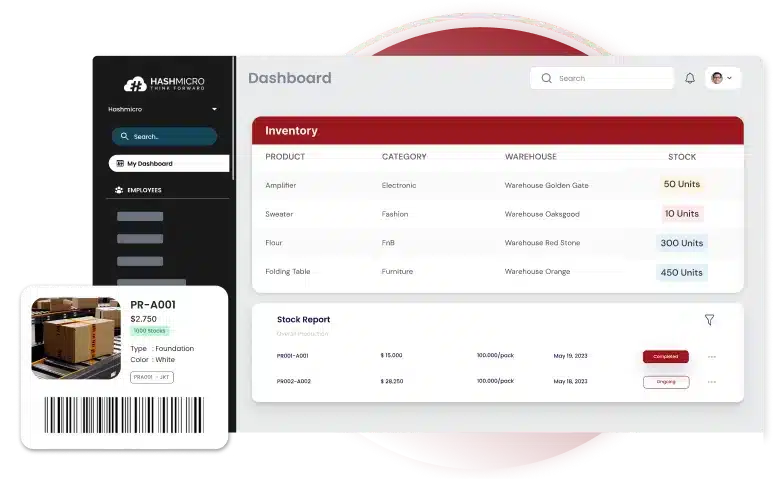Spending too much time on repetitive tasks? We get it. Manual stock replenishment feels like an endless cycle—repeatedly counting, tracking, and reordering inventory. It’s not only frustrating but also time-consuming and prone to human error.
Imagine breaking free from this tedious process while ensuring your inventory is always at optimal levels. By automating your inventory replenishment, you can save time, minimize mistakes, and focus on what truly matters for your business.
In 2025, it’s time to abandon outdated methods and embrace smarter stock management. Let us show you how!
Key Takeaways
|
Table of Content
Content Lists
What is Stock Replenishment?
Stock replenishment is a critical process that helps businesses maintain optimal inventory levels to meet demand without shortages or overstocking. Along with supply replenishment, it enhances supply chain efficiency by preventing lost sales and reducing excess storage costs.
Effective stock replenishment uses demand forecasting to predict sales trends and optimize inventory. Automation and real-time analytics streamline the process, reducing costs and manual efforts. This ensures best-selling items remain available, maximizing revenue and customer satisfaction.
Stock Replenishment vs Inventory Control
Stock replenishment and inventory control are key to efficient inventory management but serve different roles. Inventory control ensures stock accuracy, while stock replenishing focuses on timely restocking to prevent shortages. Together, they help maintain smooth operations and optimal stock levels.
By integrating both strategies, businesses can create a seamless inventory management system that minimizes disruptions and maximizes efficiency. Accurate inventory control helps identify trends and prevent overstocking, while timely replenishment ensures that high-demand products remain available without excess holding costs.
A well-balanced approach to inventory management enhances operational efficiency and profitability. Businesses that optimize inventory control and replenishment can reduce waste, improve cash flow, and ensure a better customer experience by always having the right products in stock.
Why is Stock Replenishment Important?
Stock replenishment is essential for maintaining product availability, ensuring businesses can consistently meet customer demand without delays. By preventing stockouts, companies can avoid lost sales, while minimizing overstocking helps free up capital and reduce storage costs.
A well-managed replenishment process improves operational efficiency by optimizing inventory levels and reducing waste. Businesses can enhance supply chain performance, streamline stock refill and restocking, and ensure a balanced flow of goods, leading to better cost control and resource allocation.
Efficient stock replenishment helps businesses adapt to market changes and demand fluctuations. Automation and data-driven forecasting prevent disruptions, improve customer satisfaction, and boost competitiveness.
Still unsure if automated stock replenishment suits your business? Try a free demo today and consult with our experts to see how it can optimize your inventory management. Click the banner below to get started!
How Does Stock Replenishment Work?
Stock replenishment is essential for ensuring businesses maintain the right inventory levels to meet demand efficiently. This process involves tracking stock, identifying when items need to be reordered, and ensuring timely replenishment to prevent shortages or excess inventory.
A well-structured replenishment strategy helps businesses avoid stockouts that lead to lost sales while preventing overstocking that ties up capital and increases storage costs. Here’s a step-by-step guide on how stock replenishment works:
- Monitor inventory levels: Continuously track stock to ensure it remains within optimal levels and does not drop below critical thresholds.
- Determine reorder points: To maintain smooth operations, set predefined reorder points based on sales trends, demand forecasts, and supplier lead times.
- Initiate reordering: Once stock levels reach the reorder point, a replenishment order is automatically or manually triggered.
- Place orders with suppliers: Orders are sent to vendors through manual requests or automated inventory systems that streamline the purchasing process.
- Receive and store inventory: Upon arrival, new stock is checked for accuracy, updated in the inventory system, and placed in the designated storage location.
- Update and verify inventory records: Adjust stock levels in the system to ensure data accuracy for better forecasting and inventory control.
Best Practices for Effective Stock Replenishment

Effective stock replenishment is essential for maintaining a seamless supply chain and ensuring product availability. Businesses must balance having enough inventory to meet customer demand without overstocking, which can tie up capital and increase storage costs.
By implementing strategic replenishment practices, companies can optimize inventory management, reduce the risk of stockouts, and enhance operational efficiency.
Key strategies for optimized stock replenishment:
- Establish precise reorder points
Analyzing historical sales data, demand fluctuations, and supplier lead times can help determine the ideal reorder levels for each product. Setting accurate reorder points ensures timely replenishment without excessive inventory buildup. - Utilize demand forecasting
Leverage data-driven forecasting tools to predict future inventory needs based on seasonal trends, purchasing patterns, and market conditions. A proactive approach to demand forecasting allows businesses to adjust stock levels dynamically and prevent shortages or excess stock. - Automate replenishment processes
Integrate inventory management software to monitor stock levels in real time and automate reorder triggers. Automation minimizes manual work, enhances accuracy, and speeds up procurement, ensuring a consistent supply of in-demand products. - Maintain an adequate safety stock
Keep a buffer stock to accommodate unexpected spikes in demand or supplier delays. A well-calculated safety stock strategy helps prevent disruptions in supply chain operations, maintaining business continuity and customer satisfaction.
Demand Forecasting Techniques
Demand forecasting is a cornerstone of effective stock replenishment. It involves predicting future sales to maintain optimal inventory levels. Businesses utilize techniques like historical sales analysis, market trend assessment, and customer behavior studies to make accurate demand predictions.
Advanced analytics tools further enhance this process by providing real-time data insights, enabling companies to adapt swiftly to market fluctuations and maintain effective replenishment strategies year-round.
Implementing automated demand forecasting systems helps businesses respond proactively to shifting market demands. By leveraging real-time inventory tracking and predictive analytics, companies can minimize stock outs, reduce excess inventory, and enhance overall operational efficiency.
Periodic vs. Demand-Based Replenishment
Businesses commonly adopt one of two stock replenishment methods: periodic or demand-based. Periodic replenishment follows a fixed schedule, such as weekly or monthly restocking, regardless of actual demand fluctuations.
This approach suits industries with stable sales patterns and predictable inventory needs. Conversely, demand-based replenishment adjusts stock levels in real-time based on customer demand.
This method is particularly effective in fast-paced industries and dynamic markets, such as e-commerce and retail. Companies operating in highly competitive environments may benefit from a hybrid replenishment approach, combining both strategies for maximum efficiency and flexibility.
Optimizing Warehouse Space for Efficient Replenishment
Stock replenishment is about replenishing inventory and maximizing warehouse space and layout to improve efficiency. Businesses that strategically organize their storage areas can reduce retrieval times, minimize errors, and accelerate fulfillment processes.
Optimizing warehouse layouts ensures smoother stock rotations and prevents congestion, which can slow down operations. Technologies like 3D warehouse modeling and smart shelving systems can significantly enhance space utilization for businesses with limited storage capacity.
These tools allow companies to visualize and refine their storage configurations, ensuring high-demand products are positioned for easy access. A well-structured warehouse reduces labor costs and enhances overall supply chain efficiency.
Future Trends in Stock Replenishment
As technology advances, businesses embrace automation, artificial intelligence (AI), and data analytics to optimize stock replenishment. These innovations enable companies to predict demand more accurately, automate reordering, and streamline inventory management.
Staying ahead of these trends gives businesses a competitive advantage, allowing them to adapt quickly to shifting market demands.
Adapting to Market Changes
Consumer behavior and economic conditions constantly evolve, requiring businesses to adopt flexible replenishment strategies. By closely monitoring market trends, companies can anticipate shifts in demand and adjust inventory levels accordingly.
Digital transformation plays a key role in this adaptation, with businesses leveraging real-time data to enhance decision-making and improve supply chain responsiveness.
Leveraging Inventory Management Software
Cloud-based inventory management software has revolutionized how businesses handle stock replenishment. These platforms provide real-time inventory tracking, automated reordering, and advanced reporting to improve forecasting accuracy. Beyond stock management, these tools enable businesses to track supplier performance, optimize order fulfillment, and enhance supply chain visibility.
By implementing modern inventory management solutions, businesses can significantly reduce waste, minimize costs, and ensure continuous product availability. As automation and AI-driven analytics evolve, companies adopting these technologies will gain a substantial edge in operational efficiency and profitability.
Automated Stock Replenishment with HashMicro’s Inventory Management Software

Managing inventory manually can be time-consuming and prone to errors, leading to inefficiencies and stock imbalances. With HashMicro’s Inventory Management Software, businesses can automate stock replenishment, ensuring a seamless and efficient inventory control process.
By integrating cutting-edge technology, companies can eliminate repetitive tasks, improve accuracy, and optimize stock levels to meet fluctuating demand. HashMicro’s advanced inventory solution provides businesses with a smarter way, with a free demo now, to handle replenishment, reducing human intervention while maximizing operational efficiency.
- Accurate Demand Forecasting: Businesses can utilize data-driven insights to predict future stock needs, ensuring they procure the right amount of inventory based on sales trends and consumer demand. This minimizes stockouts and prevents excessive inventory buildup.
- Waste Reduction with FIFO/FEFO: Implementing the First In, First Out (FIFO) or First Expired, First Out (FEFO) method ensures that older stock is used or sold first. This strategy reduces product spoilage, enhances stock rotation, and optimizes profitability.
- Seamless Barcode & RFID Integration: Automating inventory tracking with barcode and RFID technology streamlines stock movement, improves accuracy, and minimizes human errors. This enhances warehouse efficiency and ensures real-time inventory visibility.
- Enhanced Lot & Serial Number Tracking: Assigning unique lot and serial numbers to products improves traceability, making it easier to track inventory movement, manage recalls, and maintain quality control across storage locations.
- Automated Stock Request & Approval Workflow: Businesses with multiple outlets can automate stock requisition processes, reducing approval delays and ensuring inventory is efficiently distributed to meet demand in different locations.
- Stock Aging Analysis for Better Turnover: Evaluating inventory age helps businesses identify slow-moving and fast-selling products, allowing them to optimize stock turnover, reduce holding costs, and prevent obsolete inventory.
HashMicro’s Inventory Software automates stock replenishment, ensuring efficient inventory management across all warehouses. By leveraging this advanced system, businesses can minimize manual stock handling, enabling them to focus on growth and improving customer satisfaction.
Conclusion
Manual stock replenishment is often tedious, repetitive, and prone to errors. Automating this process helps businesses save time while ensuring optimal inventory levels. By adopting advanced replenishment strategies, companies can minimize errors and focus on more strategic operations.
With HashMicro’s Inventory Management Software, businesses can streamline stock replenishment and enhance efficiency. Automate your processes and optimize inventory management for 2025 and beyond. Ready to transform your stock management? Schedule a free demo today and discover how HashMicro can elevate your business.
Questions About Stock Replenishment
-
What is the method of stock replenishment?
Stock replenishment methods include periodic and demand-based approaches. Periodic replenishment restocks inventory at fixed intervals, while demand-based replenishment adjusts stock levels based on real-time sales data. Businesses often use automation to optimize the process and reduce stockouts.
-
What is an example of inventory replenishment?
An example of inventory replenishment is a retail store restocking popular products once they reach a minimum threshold. Another example is a restaurant ordering fresh ingredients daily based on customer demand. This ensures product availability while avoiding overstocking or wastage.
-
How to calculate stock replenishment?
Stock replenishment is calculated using the formula Reorder Point = (Average Daily Sales × Lead Time) + Safety Stock. This formula determines when to reorder inventory before it runs out. Proper forecasting helps maintain an optimal stock balance and prevents shortages.






































